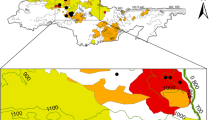Abstract
The application of Long Term fire Retardants (LTRs) for forest fire prevention and/or suppression purposes can result in chemicals leaching, from soil to the drainage water, during the annual rain fall period. In leachates, large concentrations of nitrogen (N), one of the major components of LTRs, could affect the groundwater quality. N leaching due to the application of a nitrogen phosphate based LTR was studied in laboratory microcosms. The concentrations of nitrate (NO −3 -N) and ammonium nitrogen (NH +4 -N) were measured in the resulting leachates from pots with forest soil and pine seedlings (Pinus halepensis) alone and in combination with fire. Up to 30% of the total N in the retardant was lost to leaching, primarily as NO −3 -N. The vegetation seems to decrease to some extent the N leaching. The N leaching from treated pots with a burnt tree is lower compared with that from treated pots with a living tree, due to the partial N volatilization during the fire. Although this is a laboratory study, these results may be considered as rough indications of LTR environmental implications, due to the leaching of a significant part of the retardant’s N into groundwater.
Résumé
L’application de retardants à long terme des feux (LTRs) pour la prévention des incendies en forêt et/ou leur suppression peut avoir pour résultat un lessivage chimique du sol vers les eaux de drainage, pendant la période annuelle des pluies en automne. Dans les lessivats, d’importantes concentrations en azote (N), un des composants majeur des LTRs, pourraient affecter la qualité de l’eau dans les nappes phréatiques. Le lessivage d’azote attribuable à l’application de phosphate d’azote, base des LTRs, a été étudié en conditions de laboratoire. Les concentrations de nitrate (NO −3 -N) et d’ammonium (NH +4 -N) ont été mesurées dans les lessivats issus de pots remplis de sols forestiers et plantés de semis de pins (Pinus halepensis) seuls et en combinaison avec un feu. Jusqu’à 30 % de l’azote total du retardant était perdu par lessivage, essentiellement sous forme de nitrate NO −3 . La végétation semble décroître avec l’augmentation du lessivage. Le lessivage provenant des pots contenant des arbres brûlés est plus faible que celui des pots contenant des arbres vivants, à cause d’une volatilisation partielle d’azote pendant les feux. Bien qu’il s’agisse d’une étude en laboratoire, ces résultats peuvent être considérés comme une approximation des effets environnementaux de l’application de LTRs, du fait du lessivage d’une partie significative de l’azote du retardant dans l’eau des nappes phréatiques.
Similar content being viewed by others
References
Adams R., Simmons D., Ecological effects of fire fighting foams and retardants, Proceedings of Australian Bushfire Conference, Albury, NSW, Australia, School of Environmental & Information Sciences, Charles Start University: Albury, NSW, 1999 Available at http://www.life.csu.edu.au/bushfire99/papers.
Angeler D.G., Rodriguez M., Martin S., Moreno J.M., Assessment of application-rate dependent effects of a long-term fire retardant chemical (Fire-Trol 934) on Typha domingensis germination, Environ. Int. 30 (2004) 375–381.
Bell T., Effects of fire retardants on vegetation in eastern Australian heathlands: a preliminary investigation, Research Report No. 68, Fire Management, Department of Sustainability and Environment, Victoria, 2003. Available at http://www.nre.vic.gov.au/CA256F310024B628/0/A63F217A03A BB536CA257223003A35EC/$File/Research+Report+68.pdf.
Crouch R.L., Timmenga H.J., Barber T.R., Fuchsman P.C., Post-fire surface water quality: Comparison of fire retardant versus wildfire-related effects, Chemosphere 62 (2006) 874–889.
Cummings W., Jones E., Reed D., Drummer T., Frontier function analysis to estimate the maximum relative growth rate of red pine (Pinus resinosa, Ait.) in Northern Michigan, Proceedings of a IUFRO 4.11 conference held at the University of Greenwich, June 2001.
Gimenez A., Pastor E., Zarate L., Planas E., Arnaldos J., Long-term forest fire retardants: a review of quality, effectiveness, applications and environmental considerations, Int. J. Wildl. Fire 13 (2004) 1–15.
Gould J.S., Khanna P.K., Hutchings P.T., Assesment of the effectiveness and environmental risk of Retardants to assist in wildfire control in Victoria, Research Report No. 50, CSIRO Forestry and Forest Products, Department of Natural Resources and Environment, Victoria, 2000. Available at http://www.nre.vic.gov.au/CA256F310024B628/0/0C2E1F91D1EE 1333CA257223003C639B/$File/Research+Report+50.pdf.
Hopmans P., Bickford R., Effects of fire retardant on soils of heathland in Victoria, Fire management Department of Sustainability and Environment, Victoria, Research Report No. 70, 2003. Available at http:// www.dse.vic.gov.au/fires.
Ingalsbee T., Collateral damage: the environmental effects of firefighting. Western fire ecology center-biscuit fire suppression impacts, 2004. Available at http://www.firee-cology.org/research/biscuit_suppression.html.
Kalabokidis K., Effects of wildfire suppression chemicals on people and the environment — a review, Global Nest, Int. J. 2 (2000) 129–137.
Larson D.L., Newton W.E., Anderson P.J., Stein S.J., Effect of fire retardant chemical and fire suppressant foam on shrub steppe vegetation in Northern Nevada, Int. J. Wildl. Fire 9 (1999) 115–127.
Little E.E., Calfee R.D., Environmental Implications of fire — retardant chemicals, Report to US Forest Service, 2002. Available at http://www.cerc.usgs.gov/pubs/center/pdfdocs/ECO-03.pdf.
Norris L.A., Hawkes C.L., Webb W.L., Moore D.G., Bollen W.B. and Holcombe E., A report of research on the behaviour and impact of chemical fire retardants in forest streams, Forestry Sciences Laboratory, PNW Forest and Range Experiment Station, Corvallis, Oregon, USA, 1978.
Pappa A., Tzamtzis N., Koufopoulou S., Effect of fire retardant application on phosphorus leaching from Mediterranean forest soil: short-term laboratory-scale study, Int. J. Wildl. Fire 15 (2006) 287–292.
Pausas J.G., Ribeiro E., Vallejo R., Post-fire regeneration variability of Pinus halepensis in the eastern Iberian Peninsula, For. Ecol. Manage. 203 (2004) 251–259.
Rowell D.L., Soil Science: Methods and applications, Pearson/Prentice Hall, 1994.
Xanthopoulos G., Noussia P., Small-scale evaluation of a retardant-reinforced firebreak required to stop a forest fire, Mediterranean Agronomic Institute of Chania, Crete, Greece, ACRE project, Research Report, 2000.
Author information
Authors and Affiliations
Corresponding author
Rights and permissions
About this article
Cite this article
Pappa, A.A., Tzamtzis, N.E. & Koufopoulou, S.E. Nitrogen leaching from a forest soil exposed to fire retardant with and without fire: A laboratory study. Ann. For. Sci. 65, 210 (2008). https://doi.org/10.1051/forest:2007093
Received:
Revised:
Accepted:
Issue Date:
DOI: https://doi.org/10.1051/forest:2007093




